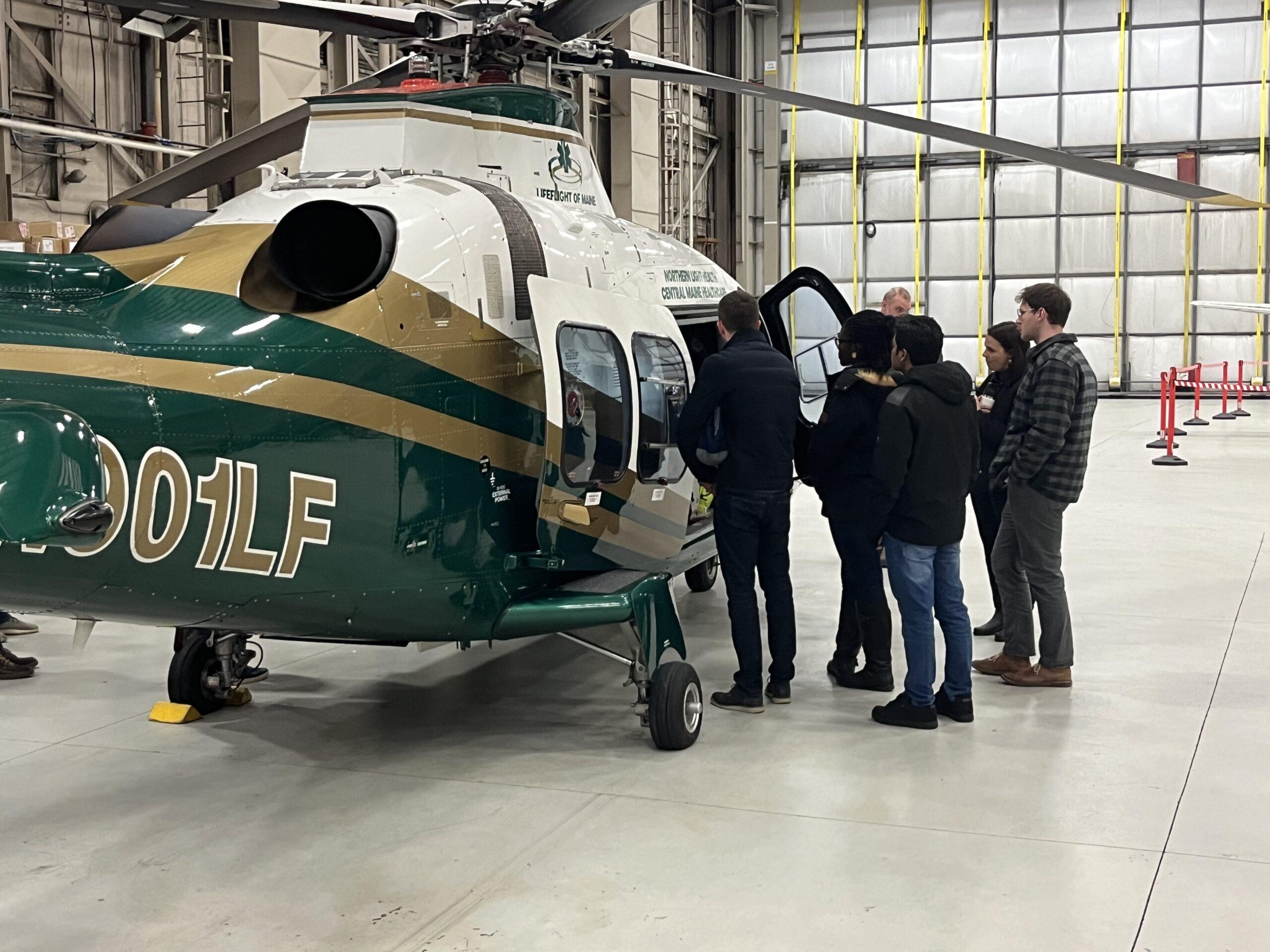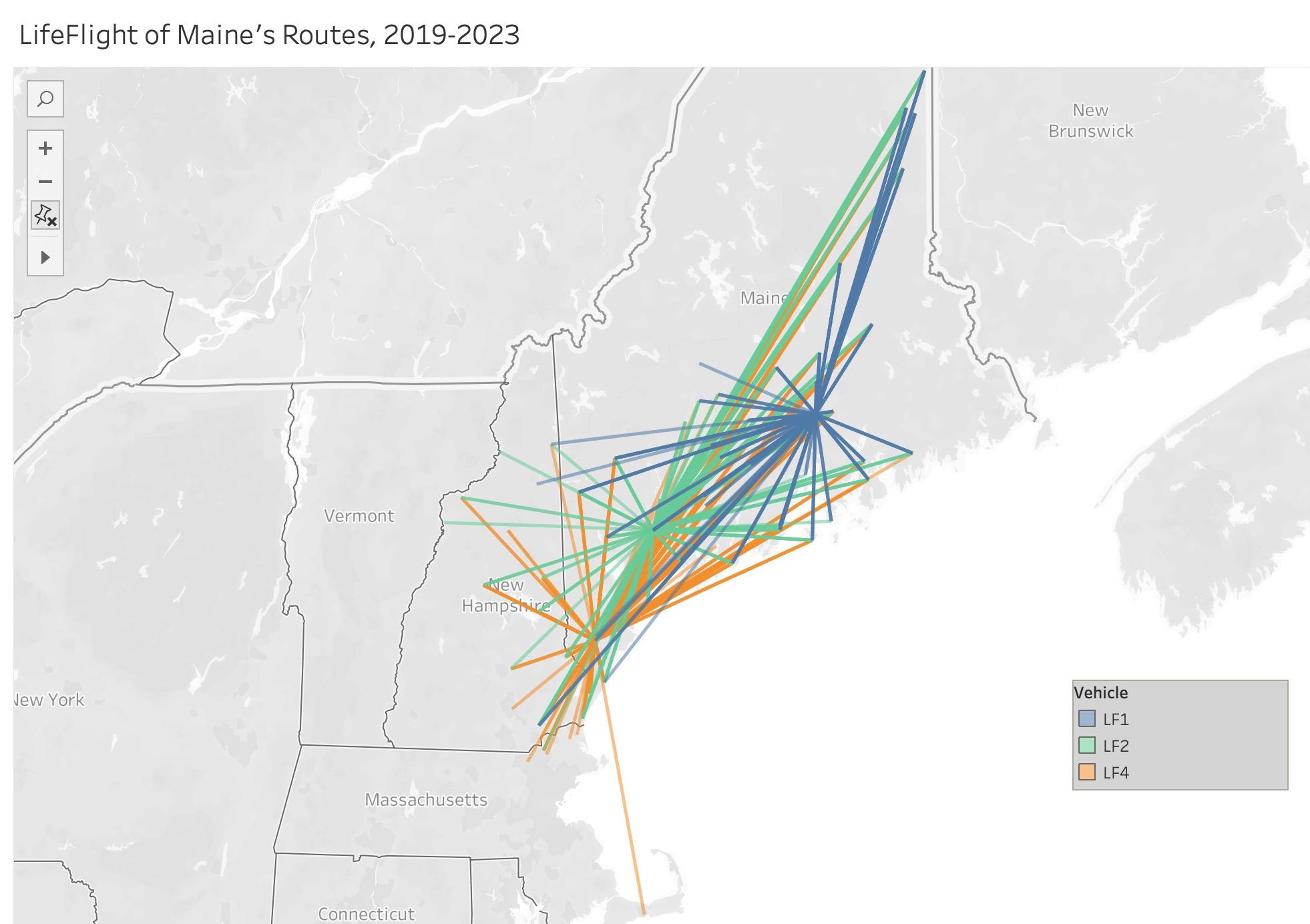Roux Data Analytics Students Work to Shorten LifeFlight Call Response Times
What can an air ambulance service learn from a group of data analytics grad students?
As it turns out, quite a lot.
This was evident on a recent Wednesday night at Northeastern University’s Roux Institute, as Roux graduate students presented to LifeFlight of Maine, proposing strategies to enhance call response times and address various operational challenges.
The presentation marked the culmination of a Northeastern University “Experiential Learning” course, wherein graduate-level students collaborate with a sponsoring organization, applying their coursework to address real business challenges or objectives.
In this case, the sponsor in question was LifeFlight of Maine, a nonprofit and the state’s only air ambulance service. The organization has been in operation for over 25 years and has served a staggering 37,000 patients. LifeFlight came to the Roux Institute with data and an idea: could the class use their data to help LifeFlight shorten their “chute time” – a term that refers to the time that elapses from the moment a call comes in, to the moment helicopter disembarks?
The class got to work. Colin Campbell, a part-time data analytics grad student and a full-time staff member at the Roux Institute, explained the importance of working with real-world data.
“When you’re learning data analytics concepts in the classroom, you’re learning with very structured, hypothetical data,” he said. “New challenges arise when working with real-world data, and you realize how critical it is to understand the industry, how data variables relate to business objectives, and how to clean and restructure data for effective analysis.”
For many LifeFlight patients, every minute matters, and these insights from the Roux students will help save lives here in Maine.”
Bill Cyr
COO, LifeFlight of Maine
As the class analyzed LifeFlight’s time stamps, they also worked to identify a variety of variables that affect chute times: the weather, the time of day or night the flight occurs, the implementation of certain FAA protocols, etc. With these variables in mind, groups created dashboards that would allow LifeFlight to better track their chute times, and to better visualize which combination of variables – pilot on duty, medical personnel on duty, time of day, weather – yielded the best results.
With this information in hand, LifeFlight has the ability to identify top performers and training opportunities. For example, if a particular pilot consistently performs well on night shifts, they might be tapped to train other pilots in optimizing nighttime chute times. Or, if a particular team of medical personnel consistently prepares quickly for a certain type of medical call, they could be called upon to train others in that area.
Bill Cyr, the COO of LifeFlight of Maine, was thrilled with the outcome of the project.
“We are already incorporating the data analysis and dashboards the students produced into our operations decisions related to chute times,” he said. “For many LifeFlight patients, every minute matters, and these insights from the Roux students will help save lives here in Maine.”

Roux grad students get a tour of a LifeFlight helicopter
During the class’s presentation to LifeFlight, a segment was allocated to showcase individual proposals developed by each of the 14 graduate students during the course.
Campbell proposed a geographic information system that would layer data like town population, 911 calls appropriate for air transport, refueling stations, and landing zones over a map of Maine, helping LifeFlight visualize important data and create an optimal transport algorithm to minimize response time.
Student Sarah McKeown proposed leveraging LifeFlight’s data to identify controllable operational variables—like transportation time and chute time — that lead to more successful patient outcomes.
McKeown, a high school math teacher who is halfway through the analytics master’s degree program at the Roux Institute, says part of the reason she started the program was to better understand how industries are using numbers to support their decision-making.
“This was my first project working with a real, local sponsor, and seeing it come together has been really cool,” McKeown said. “A beautiful symbiotic relationship forms between businesses and students when our learning ends up offering them something really valuable.”
McKeown was born and raised in Maine and completed her undergrad at the University of Maine in Farmington. She’s passionate about the Roux Institute’s hands-on approach to helping Maine businesses and organizations by integrating them into the classroom.
“I think being so deeply rooted in Maine, and having the opportunity to work with an organization whose goal is to help Maine people, that just really resonates with me,” she said. “I’m blown away by what’s happening at the Roux Institute. I feel like I get to be a part of the ripple effect that’s making a difference in Maine.”
Cyr is optimistic about future projects with Roux students.
“We were impressed by [the students’] thoughtfulness, inquisitiveness, and professionalism, and we enjoyed digging into the details of emergency medicine and helicopter aviation with them,” he said. “We look forward to collaborating more with the Roux Institute and these future Maine business leaders.”

A data visualization of helicopter transports in Maine between 2019-2023